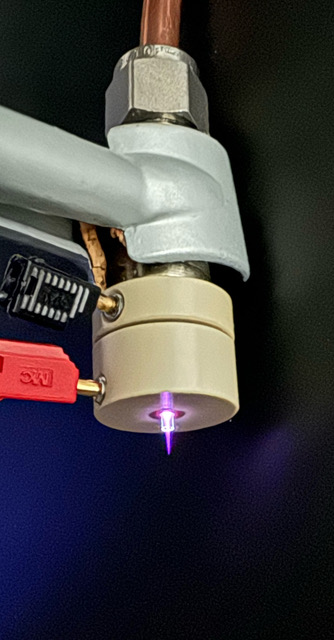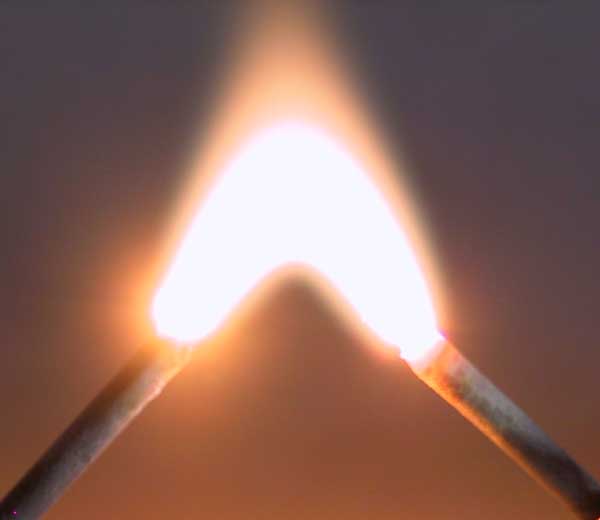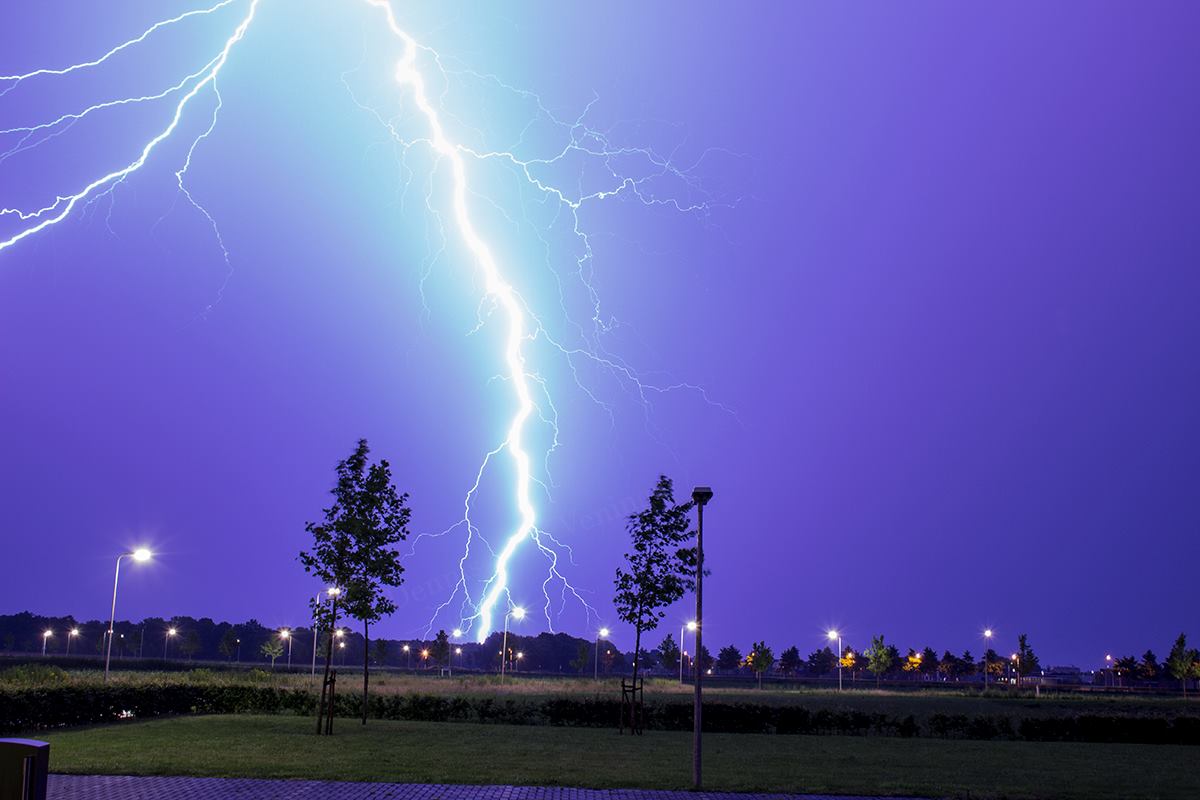|
Atmospheric-pressure Plasma
Atmospheric-pressure plasma (or AP plasma or normal pressure plasma) is a plasma in which the pressure approximately matches that of the surrounding atmosphere – the so-called normal pressure. Fundamentals of atmospheric-pressure plasma generation A discharge can be ignited and plasma can be sustained when a DC voltage that is delivered to the gas medium via electrodes is higher than the breakdown voltage for the gas. The relationship between this breakdown voltage and the pd product—where p is the gas pressure and d is the distance between the electrodes—is referred to as Paschen's law. For a range of gas molecules, the breakdown voltage estimated by Paschen's law has a minimum value of around pd = 1-10 Torr cm. This suggests that in order to get a practical breakdown voltage for the gas discharge to ignite, a smaller electrode-gap distance is preferred as gas pressure increases. The Paschen-minimum condition at atmospheric pressure can be reached at a gap spacing of cons ... [...More Info...] [...Related Items...] OR: [Wikipedia] [Google] [Baidu] |
Corona Discharge
A corona discharge is an electrical discharge caused by the ionization of a fluid such as air surrounding a conductor (material), conductor carrying a high voltage. It represents a local region where the air (or other fluid) has undergone electrical breakdown and become conductive, allowing charge to continuously leak off the conductor into the air. A corona discharge occurs at locations where the strength of the electric field (potential gradient) around a conductor exceeds the dielectric strength of the air. It is often seen as a bluish glow in the air adjacent to pointed metal conductors carrying high voltages, and emits light by the same mechanism as in a gas discharge lamp and in glow discharge, namely, via a combination of bremsstrahlung radiation and changes in electronic state that produce discrete spectral lines. Corona discharges can also happen in weather, such as thunderstorms, where objects like ship masts or airplane wings have a charge significantly different ... [...More Info...] [...Related Items...] OR: [Wikipedia] [Google] [Baidu] |
Dielectric Barrier Discharge
Dielectric-barrier discharge (DBD) is the electrical discharge between two electrodes separated by an insulating dielectric barrier. Originally called silent (inaudible) discharge and also known as ozone production discharge or partial discharge, it was first reported by Ernst Werner von Siemens in 1857.Kogelschatz, Ulrich, Baldur Eliasson, and Walter EgliFrom ozone generators to flat television screens: history and future potential of dielectric-barrier discharges Pure Applied Chemistry, Vol. 71, No. 10, pp. 1819–1828, 1999. Retrieved on 5 August 2007. Process The process normally uses high voltage alternating current, ranging from lower RF to microwave frequencies. However, other methods were developed to extend the frequency range all the way down to the DC. One method was to use a high resistivity layer to cover one of the electrodes. This is known as the resistive barrier discharge.M. Laroussi, I. Alexeff, J. P. Richardson, and F. F. Dyer " The Resistive Barrier D ... [...More Info...] [...Related Items...] OR: [Wikipedia] [Google] [Baidu] |
Laser Schlieren Deflectometry
Laser schlieren deflectometry (LSD) is a method for a high-speed measurement of the Temperature, gas temperature in Microscopic scale, microscopic dimensions, in particular for temperature peaks under dynamic conditions at atmospheric pressure. The principle of LSD is derived from schlieren photography: a narrow laser beam is used to scan an area in a gas where changes in properties are associated with characteristic changes of refractive index. Laser schlieren deflectometry is claimed to overcome limitations of other methods regarding temporal and spatial resolution. The theory of the method is analogous to Rutherford scattering, the scattering experiment of Ernest Rutherford from 1911. However, instead of alpha particles scattering, scattered by Gold, gold atoms, here an Ray (optics), optical ray is deflected by hot spots with unknown temperature. A general equation of LSD describes the dependence of the measured maximum deflection of the ray ''δ''1 on the local maximum of the ... [...More Info...] [...Related Items...] OR: [Wikipedia] [Google] [Baidu] |
Adhesion
Adhesion is the tendency of dissimilar particles or interface (matter), surfaces to cling to one another. (Cohesion (chemistry), Cohesion refers to the tendency of similar or identical particles and surfaces to cling to one another.) The forces that cause adhesion and cohesion can be divided into several types. The intermolecular forces responsible for the function of various kinds of stickers and sticky tape fall into the categories of chemical adhesion, dispersive adhesion, and diffusive adhesion. In addition to the cumulative magnitudes of these intermolecular forces, there are also certain emergent mechanical effects. Surface energy Surface energy is conventionally defined as the work (physics), work that is required to build an area of a particular surface. Another way to view the surface energy is to relate it to the work required to cleave a bulk sample, creating two surfaces. If the new surfaces are identical, the surface energy γ of each surface is equal to h ... [...More Info...] [...Related Items...] OR: [Wikipedia] [Google] [Baidu] |
Plasma Cleaning
Plasma cleaning is the removal of impurities and contaminants from surfaces through the use of an energetic plasma (physics), plasma or dielectric barrier discharge (DBD) plasma created from gaseous species. Gases such as argon and oxygen, as well as mixtures such as air and hydrogen/nitrogen are used. The plasma is created by using high frequency voltages (typically kHz to >MHz) to ionise the low pressure gas (typically around 1/1000 atmospheric pressure), although atmospheric pressure plasmas are now also common. Methods In plasma, gas atoms are excited to higher energy states and also ionized. As the atoms and molecules 'relax' to their normal, lower energy states they release a photon of light, this results in the characteristic “glow” or light associated with plasma. Different gases give different colors. For example, oxygen plasma emits a light blue color. A plasma’s activated species include atoms, molecules, ions, electrons, radical (chemistry), free radicals, metas ... [...More Info...] [...Related Items...] OR: [Wikipedia] [Google] [Baidu] |
Plasma Activation
Plasma activation (or plasma functionalization) is a method of surface functionalization, surface modification employing plasma processing, which improves surface adhesion properties of many materials including metals, glass, ceramics, a broad range of polymers and textiles and even natural materials such as wood and seeds. Plasma functionalization also refers to the introduction of functional groups on the surface of exposed materials. It is widely used in industrial processes to prepare surfaces for bonding, gluing, coating and painting. Plasma processing achieves this effect through a combination of reduction of metal oxides, ultra-fine plasma cleaning , surface cleaning from organic contaminants, modification of the surface topography and deposition of functional chemical groups. Importantly, the plasma activation can be performed at atmospheric pressure using air or typical industrial gases including hydrogen, nitrogen and oxygen. Thus, the surface functionalization is achieved ... [...More Info...] [...Related Items...] OR: [Wikipedia] [Google] [Baidu] |
Piezoelectric Direct Discharge Plasma
Piezoelectric direct discharge (PDD) plasma is a type of cold non-equilibrium plasma, generated by a direct gas discharge of a high voltage piezoelectric transformer. It can be ignited in air or other gases in a wide range of pressures, including atmospheric. Due to the compactness and the efficiency of the piezoelectric transformer, this method of plasma generation is particularly compact, efficient and cheap. It enables a wide spectrum of industrial, medical and consumer applications. Background Cold non-equilibrium atmospheric-pressure plasmas can be produced by high voltage discharges in the atmospheres of various working gases. The following 3 types of electric discharges found most applications in industrial processes: * Electric arc discharges are self-sustaining DC discharges characterized by high electric currents, which are drawn from the cathode by intensive thermionic and field emission. Due to the intense currents, the volume of the arc reaches thermal equilibrium ... [...More Info...] [...Related Items...] OR: [Wikipedia] [Google] [Baidu] |
Dielectric Barrier Discharge
Dielectric-barrier discharge (DBD) is the electrical discharge between two electrodes separated by an insulating dielectric barrier. Originally called silent (inaudible) discharge and also known as ozone production discharge or partial discharge, it was first reported by Ernst Werner von Siemens in 1857.Kogelschatz, Ulrich, Baldur Eliasson, and Walter EgliFrom ozone generators to flat television screens: history and future potential of dielectric-barrier discharges Pure Applied Chemistry, Vol. 71, No. 10, pp. 1819–1828, 1999. Retrieved on 5 August 2007. Process The process normally uses high voltage alternating current, ranging from lower RF to microwave frequencies. However, other methods were developed to extend the frequency range all the way down to the DC. One method was to use a high resistivity layer to cover one of the electrodes. This is known as the resistive barrier discharge.M. Laroussi, I. Alexeff, J. P. Richardson, and F. F. Dyer " The Resistive Barrier D ... [...More Info...] [...Related Items...] OR: [Wikipedia] [Google] [Baidu] |
Electric Arc
An electric arc (or arc discharge) is an electrical breakdown of a gas that produces a prolonged electrical discharge. The electric current, current through a normally Electrical conductance, nonconductive medium such as air produces a plasma (physics), plasma, which may produce visible light. An arc discharge is initiated either by thermionic emission or by field emission. After initiation, the arc relies on thermionic emission of electrons from the electrodes supporting the arc. An arc discharge is characterized by a lower voltage than a glow discharge. An archaic term is voltaic arc, as used in the phrase "voltaic arc lamp". Techniques for arc suppression can be used to reduce the duration or likelihood of arc formation. In the late 19th century, Arc lamp, electric arc lighting was in wide use for Street light#Arc lamps, public lighting. Some low-pressure electric arcs are used in many applications. For example, fluorescent lamp, fluorescent tubes, mercury, sodium, and met ... [...More Info...] [...Related Items...] OR: [Wikipedia] [Google] [Baidu] |
Plasma (physics)
Plasma () is a state of matter characterized by the presence of a significant portion of charged particles in any combination of ions or electrons. It is the most abundant form of ordinary matter in the universe, mostly in stars (including the Sun), but also dominating the rarefied intracluster medium and Outer space#Intergalactic space, intergalactic medium. Plasma can be artificially generated, for example, by heating a neutral gas or subjecting it to a strong electromagnetic field. The presence of charged particles makes plasma electrically conductive, with the dynamics of individual particles and macroscopic plasma motion governed by collective electromagnetic fields and very sensitive to externally applied fields. The response of plasma to electromagnetic fields is used in many modern devices and technologies, such as plasma display, plasma televisions or plasma etching. Depending on temperature and density, a certain number of neutral particles may also be present, in wh ... [...More Info...] [...Related Items...] OR: [Wikipedia] [Google] [Baidu] |
Microwave
Microwave is a form of electromagnetic radiation with wavelengths shorter than other radio waves but longer than infrared waves. Its wavelength ranges from about one meter to one millimeter, corresponding to frequency, frequencies between 300 MHz and 300 GHz, broadly construed. A more common definition in radio-frequency engineering is the range between 1 and 100 GHz (wavelengths between 30 cm and 3 mm), or between 1 and 3000 GHz (30 cm and 0.1 mm). In all cases, microwaves include the entire super high frequency, super high frequency (SHF) band (3 to 30 GHz, or 10 to 1 cm) at minimum. The boundaries between far infrared, terahertz radiation, microwaves, and ultra-high-frequency (UHF) are fairly arbitrary and differ between different fields of study. The prefix ' in ''microwave'' indicates that microwaves are small (having shorter wavelengths), compared to the radio waves used in prior radio technology. Frequencies in the micr ... [...More Info...] [...Related Items...] OR: [Wikipedia] [Google] [Baidu] |





